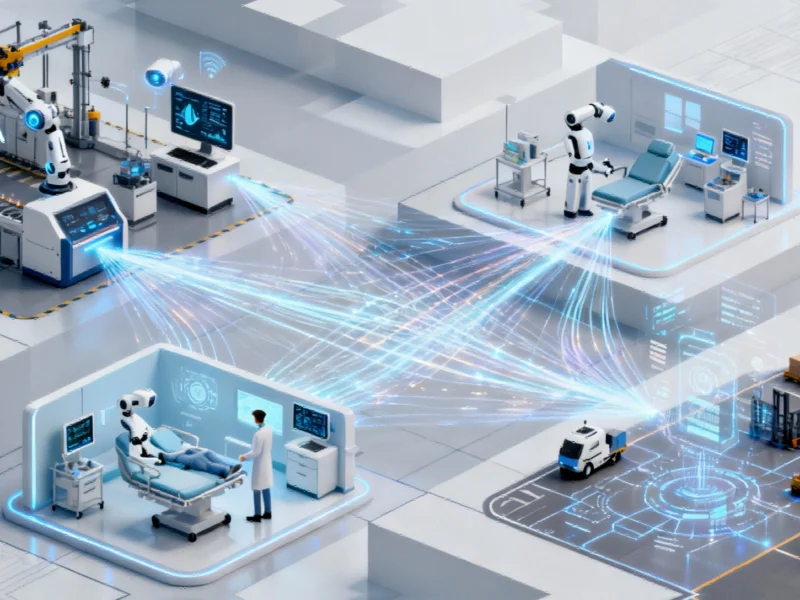The Evolution from Digital to Physical AI
Artificial intelligence is breaking free from its digital confines and entering the physical world, transforming how businesses operate at a fundamental level. While traditional AI has primarily lived in data centers and software applications, physical AI represents the next evolutionary step—embedding intelligence directly into machinery, robots, and operational systems that interact with our physical environment. This transition marks a significant shift that C-suite leaders are now navigating as they move beyond experimental pilots toward full-scale implementation.
The implications span across industries—from manufacturing plants where AI-driven sensors predict equipment failures before they occur, to healthcare facilities deploying robotic assistants and smart diagnostic systems. Even global supply chains are being revolutionized by intelligent networks that optimize routes, reduce waste, and enhance sustainability. What distinguishes physical AI is its tangible impact: creating safer working environments, more reliable products, and stronger customer relationships through consistently improved outcomes.
The Scaling Challenge: From Pilot to Enterprise Implementation
While many organizations have successfully run physical AI pilots, scaling these initiatives presents unique challenges that demand strategic planning and substantial investment. Successful pilots typically identify specific workflows where embedded intelligence can deliver immediate value—whether streamlining operations, boosting productivity, or enabling entirely new services. However, enterprise-wide deployment requires significant infrastructure upgrades, robust data management systems, and workforce transformation programs.
The defense sector offers compelling parallels in technological scaling, particularly as European defense investment rises and examines what role advanced computing can play in modern security infrastructure. Similarly, industrial control systems are evolving to accommodate these new demands, with specialized control platforms exploring how physical AI can enhance operational capabilities across various sectors.
Data Infrastructure: The Foundation of Physical AI Success
Physical AI systems depend on high-quality, secure, and accessible data to function effectively. Unlike digital AI applications that can work with imperfect data, physical AI operating in real-world environments requires exceptionally reliable data inputs. Businesses must establish comprehensive data governance frameworks that ensure data quality, proper contextualization, correct formatting, and robust cybersecurity measures.
The computational demands of physical AI are driving innovations in supporting infrastructure, including data center storage evolution where liquid cooling technologies are emerging as critical solutions for managing the heat generated by AI processing workloads. These infrastructure considerations become particularly important when government funding uncertainties create challenges for technological advancement, highlighting the need for resilient implementation strategies.
Regulatory Compliance and Risk Management
The physical dimension of AI introduces complex regulatory considerations that executives must address proactively. As organizations integrate robotics and autonomous systems into their operations, they confront new questions about privacy rights, safety protocols, security procedures, and insurance requirements. Each of these elements represents potential failure points if not properly managed.
Comprehensive risk management strategies must account for both technical and human factors. This includes establishing clear safety protocols for human-robot interaction, implementing privacy safeguards for data collection in physical spaces, and ensuring compliance with evolving regulatory standards. The consequences of neglecting these aspects can be severe—from operational failures to reputational damage and legal liabilities.
Talent Transformation and Human-Machine Collaboration
The integration of physical AI necessitates significant workforce development initiatives. Employees need new skills to work effectively alongside intelligent systems, requiring updated training programs that address both technical competencies and safety protocols. This human dimension is crucial—physical AI achieves its greatest potential when enhancing human capabilities rather than replacing them.
Companies like Chobani are demonstrating how substantial funding investments can drive technological transformation, while research organizations are using AI to unlock epigenetic breakthroughs that could revolutionize multiple industries. These examples illustrate the broader pattern of organizations investing in both technology and talent to capitalize on physical AI opportunities.
Strategic Implementation Framework
Successful physical AI adoption requires a structured approach that balances innovation with operational stability. Executive leadership should focus on three key areas: identifying high-impact use cases aligned with business objectives, establishing agile testing methodologies that enable rapid learning, and developing governance frameworks that ensure responsible implementation.
The most effective strategies recognize that humans must remain in the loop—particularly for applications involving heavy machinery, medical diagnostics, or safety-critical systems. This human oversight provides the essential trust foundation that enables physical AI systems to operate effectively while managing risks.
The Future Competitive Landscape
Physical AI represents more than incremental improvement—it constitutes a fundamental shift in how companies create and deliver value. Organizations that master this transition will not only achieve operational efficiencies but will potentially redefine their industries. The ability to integrate intelligent physical systems into core business processes will become a significant competitive differentiator in the coming years.
For forward-thinking executives, the blueprint is clear: start with strategic pilots, build robust data and infrastructure foundations, address regulatory requirements proactively, invest in workforce development, and maintain human oversight throughout implementation. Companies that embrace this approach position themselves not just to adapt to the future of work, but to actively shape it through innovative applications of physical AI technology.
Based on reporting by {‘uri’: ‘fortune.com’, ‘dataType’: ‘news’, ‘title’: ‘Fortune’, ‘description’: ‘Unrivaled access, premier storytelling, and the best of business since 1930.’, ‘location’: {‘type’: ‘place’, ‘geoNamesId’: ‘5128581’, ‘label’: {‘eng’: ‘New York City’}, ‘population’: 8175133, ‘lat’: 40.71427, ‘long’: -74.00597, ‘country’: {‘type’: ‘country’, ‘geoNamesId’: ‘6252001’, ‘label’: {‘eng’: ‘United States’}, ‘population’: 310232863, ‘lat’: 39.76, ‘long’: -98.5, ‘area’: 9629091, ‘continent’: ‘Noth America’}}, ‘locationValidated’: False, ‘ranking’: {‘importanceRank’: 213198, ‘alexaGlobalRank’: 5974, ‘alexaCountryRank’: 2699}}. This article aggregates information from publicly available sources. All trademarks and copyrights belong to their respective owners.



